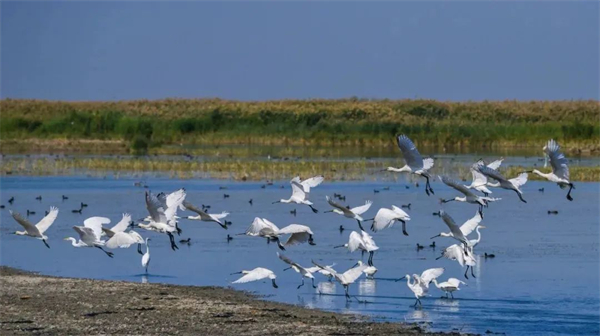Wuliangsu Lake selected as National Important Wetland

A flock of migratory birds rests at Wuliangsu Lake. [Photo/Meet Bayannuur]
The National Forestry and Grassland Administration announced on Nov 1 that 29 wetlands are being proposed for designation as National Important Wetlands.
The list includes Wuliangsu Lake in Bayannuur city, in North China's Inner Mongolia autonomous region.
Located at the top of a "几"-shaped bend in the Yellow River, Wuliangsu Lake is the largest wetland lake in the Yellow River Basin. It plays a crucial role in regulating the water volume and quality, preventing ice jams and floods.
The lake serves as a convergence zone of various ecological functions in northern China and is a natural ecological barrier for controlling the sources of sandstorms in the Beijing-Tianjin region.
Wuliangsu Lake is bordered by three major deserts to its west: the Tengger Desert, the Ulan Buh Desert, and the Kubuqi Desert.
However, due to the presence of the lake, the deserts have halted their expansion to the west of Baotou, effectively preventing the eastward invasion of the deserts and protecting the ecosystem in Hohhot, Baotou, and even the Beijing-Tianjin-Hebei region.
In Bayannuur, annual precipitation is generally less than 200 millimeters. However, the annual rainfall near Wuliangsu Lake and Wula Mountain in the city can reach up to 350 millimeters. The existence of the lake has formed a unique microclimate in the area.
Wuliangsu Lake replenishes the atmosphere with 360 million cubic meters of water every year and adds 66 million cubic meters of groundwater, resulting in high levels of humidity and precipitation in the surrounding areas.
Due to the increased humidity, the lake has become one of the nine major pathways for migratory birds in the world. It is a rare migratory bird route in the desert region.
Recent surveys and observations have found that more than 260 species of birds migrate through Wuliangsu Lake and breed in its surroundings. This makes the lake not only an ecological wonder, but also a vital stopover for birds on their seasonal migrations.



 Print
Print Mail
Mail


